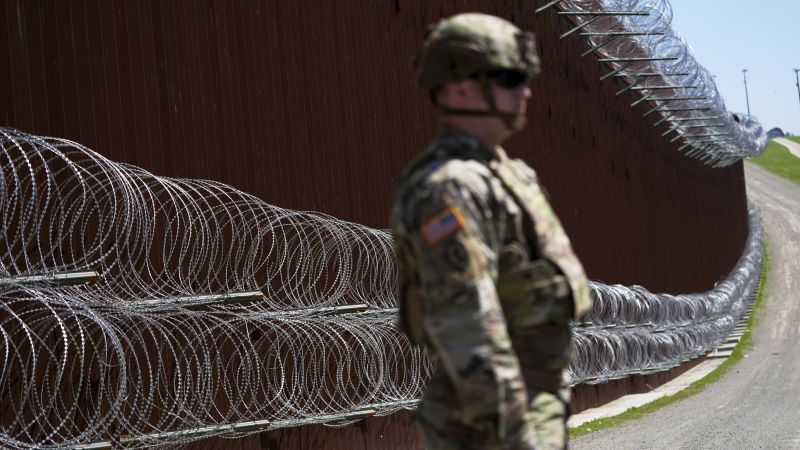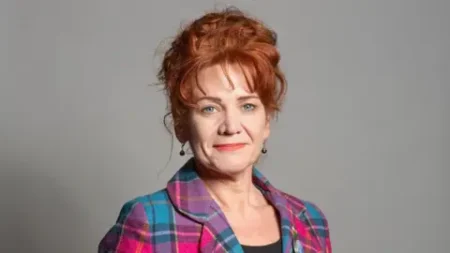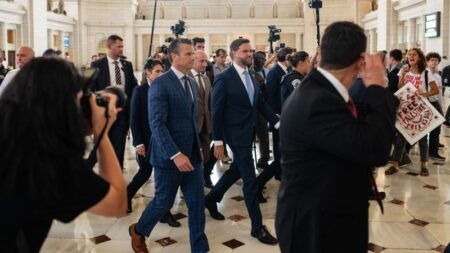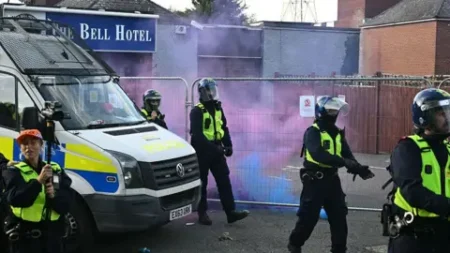In a significant development regarding immigration and national security, U.S. Department of Homeland Security Secretary Kristi Noem took to the podium on Tuesday in Santa Teresa, New Mexico, to announce an innovative approach to bolstering the southern border wall. During a news conference, she revealed that the government would commence painting the wall black, a directive reportedly inspired by former President Donald Trump. The decision is part of a broader strategy to enhance border security and prevent illegal crossings.
Secretary Noem highlighted the wall’s daunting physical characteristics. According to her, the structure’s height makes it exceptionally difficult to climb, and its deep foundation further complicates any attempts to tunnel underneath it. She stated, “It’s tall, which makes it very, very difficult to climb, almost impossible.” The addition of black paint is intended to exacerbate the wall’s heat exposure, thereby making it even less inviting for potential climbers. The logic is straightforward: in the sweltering temperatures of the southern border region, a black surface absorbs more heat, creating a psychologically and physically daunting barrier.
Moreover, Secretary Noem articulated that this initiative was in direct alignment with Trump’s vision. “That is specifically at the request of the president,” she stated, explaining his awareness of how color choices can impact temperature. The objective is to develop a border barrier that is not only formidable in appearance but also functionally deterrent in nature. It is a calculated move to address the growing issues surrounding immigration politics and the ongoing debates over how best to manage the United States’ southern border.
Additionally, Chief Michael Banks of the U.S. Border Patrol spoke about the advantages of using black paint, emphasizing its protective qualities. He noted that the painted surface would serve as a shield against rust and deterioration, which extends the life span of the steel structure. This indicates a broader initiative not only to uphold physical security but also to maintain the integrity of the border infrastructure.
The backdrop of Noem’s announcement is significant. The Trump administration reported that June saw just over 6,000 apprehensions along the southern border, a 15% decline from a previous March record. The wall itself surfaced as a central tenet of Trump’s restrictive immigration policies during his first term, and now, as he embarks on a second term, the emphasis appears to have shifted towards enhancing deportations and increasing enforcement measures within the United States rather than solely building new structures.
While Secretary Noem did not disclose the financial implications of painting the wall, she underscored the substantial funding that has been allocated for border security initiatives. The administration has managed to secure approximately $46.5 billion via the “One Big Beautiful Bill Act,” which aims to modernize the border barrier system, including plans to complete 700 miles of the primary wall. The announcement of the painting initiative fits within this larger context of modernization and fortification of border defenses.
In a further elaboration of the current construction efforts, Noem revealed that the government is actively building roughly half a mile of barrier each day. The border wall is being tailored to reflect the geographical variances along the southern perimeter of the United States. “The border wall will look very different based on the topography and the geography of where it is built,” she explained, signifying a thoughtful approach to construction that takes local challenges into account.
Moreover, to complement the physical fortifications, Noem mentioned the deployment of advanced technologies such as cameras and sensors, alongside “water-borne infrastructure.” This incorporation of technology reflects a forward-thinking strategy aimed at supplementing traditional security measures with modern surveillance capabilities, further enhancing the government’s ability to monitor and enforce immigration laws effectively.
As the Trump administration continues to assert its hardline stance on immigration, the introduction of black paint on the southern border wall is symbolic of a broader approach towards national security that merges physical fortifications with cutting-edge technology. The evolving landscape of immigration politics in the United States remains a pivotal focus, underscoring the complexities surrounding national security and public policy.











